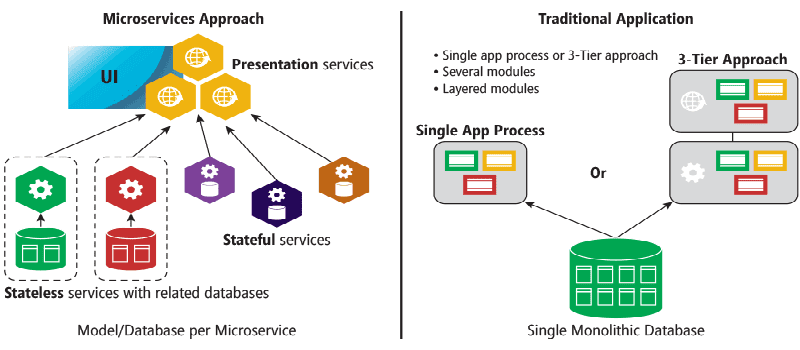Mobile device users are rapidly becoming the user’s favored instruments of choice for browsing the Internet. With market leaders centering on providing customers with exceptional user experiences, we are now seeing a rapid rise in consumer expectations, which compels, including the innovation of the mobile experiences you offer. Just implementing a mobile-first approach isn’t sufficient anymore. While your users may make-do with a responsive website in the early period, a shift to mobile apps provides you substantial leverage over your contemporaries. The key to successful mobile applications isn’t just limited to excellent design and continuous development. The development teams need to speed up the delivery of benefits that mobile apps offer to users. Implementation of the agile procedure, adopting a DevOps strategy, and making a move to the microservices model of creating a cloud-based application gives you a unique business advantage. Microservices enable the development teams to own the entire project development cycle. It provides much-needed flexibility in mobile app development services. Teams can work upon the data collected from users to incorporate changes within the app components on a real-time basis resulting in the DevOps procedure becoming more dynamic and the development teams more agile.
Flexible integration and code creation suit rapidly changing, customer-facing apps, which pushes businesses to evaluate microservices for mobile applications. Microservices in mobile application development boost modularization — breaking the architecture apart into independent services and groups of services. With services lined up around business function and still secluded from each other, developers can deliver the quick updates and recent feature releases that mobile users expect. Since microservices communicate via APIs, mobile application developers can opt for the most appropriate technology stack and language for each service or business flow, instead of limiting the entire project to one. However, microservices aren’t the only way to business mobile app development. Low-code platforms also tout a simple procedure to build mobile apps.
What are Microservices?

Microservices architecture is an essential architectural innovation that is a useful alternative for building complicated software applications. It involves the fragmentation of large applications into loosely coupled smaller services. Each microservice focuses on separate business functionality. Every microservice can be independently deployed, tweaked with, and redeployed without compromising the application integrity — the loose combination of microservices lead to the facilitation of rapid deployments. The features build as a result of user feedback, thus quickly reach the users.
How do microservices differ from conventional development practices?

In the conventional monolithic app architecture, designs all the constituents of the code as a single, cohesive unit in which the constituents are independent and interconnected. Any updates the developers require to make results in alterations made to the whole stack. Adopting a new framework or shifting to a new tech stack needs a substantial overhaul and rewriting of the entire code. In contrast, microservices architecture has the system distributed into individual services that can run as autonomous processes and communicate with each other, utilizing APIs. Containerization enables the encapsulation of the services, and operations run in parallel, thereby making the existing infrastructure easy to maintain. Any changes or updates performed on individual services without affecting the entire system.
Benefits of microservices architecture in app development

- Improved productivity and agility
Microservices are made, deployed, and tested individually of other components in the system, which results in enhanced team agility and rapid iteration cycles. The developers have the elasticity to use the framework or language most appropriate for the functionality developed; this ramps up productivity by radically reducing the amount of code to be written. It also increases the maintainability of the application. Breaking down complex apps into manageable services improves the performance of agile teams.
- Accelerated velocity and scalability
Scaling of various microservices components at runtime takes place individually; this facilitates more productive resource utilization. We can shift the workload of an element to an infrastructure that is best suited for the task. Microservices offer accelerated development speed combined with on-demand scalability. The flexibility of the cloud-native environments can be effortlessly leveraged by the microservices making scaling cost-effective through optimal use of infrastructural resources. Microservices also ensures that the application is more responsive to market requirements. The agile methodology enables you to roll out robust digital capabilities in response to real-time market requirements.
- Continuous deployment
In conventional monolithic systems, dedicated teams work on distinct functions. The introduction of microservices leads to cross-functional teams managing the complete application lifecycle in a continuous delivery model. With various team members, including testers, developers, and operations teams working simultaneously on a development testing, single service and debugging takes place in continual iterations. The incremental development results in a constant cycle which writes, tests, and deploys the code consistently while incorporating relevant feedback.
- The rise in cross-functional teams
Carrying out software development and deployment could be a tedious job when, while working with extended teams. Microservices result in improved independence for the developer. They can work independently, resulting in faster decision making. The cross-functional teams in microservices architecture consist of empowered individuals who can make faster decisions. Working in smaller groups and close-knit teams result in more freedom to the individual team members and quicker technical decision making.
- Flexibility in utilizing technologies and access to a broader talent pool
Since each developed microservice can be written using different technology, the development team is free to opt for the tech stack that would be most suitable for the specific service. Decoupled services written in various programming languages can easily coexist, add new components continuously, and perform scaling at an individual level. The flexibility that microservices offer also enables you access to a broader talent pool.
Summary
While the business profits of shifting to a microservices architecture are huge, the transformation needs to be sensibly monitored and strategically implemented. Implementing a DevOps culture, with robust monitoring is essential for an effective shift to the microservices architecture. The ramp in flexibility and speed has to balance with an associated increase in complexity.






